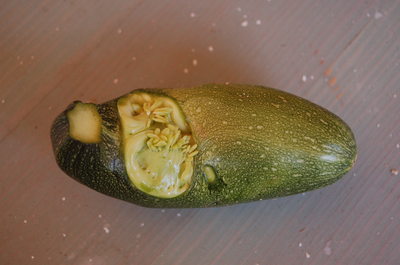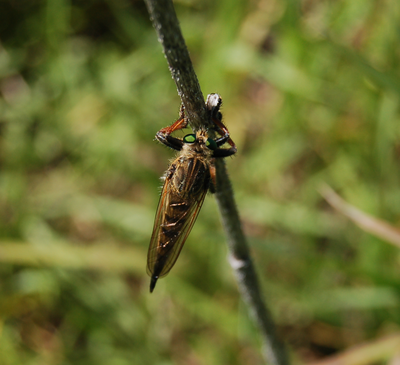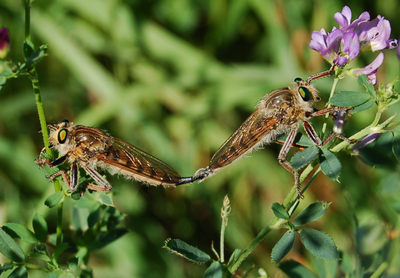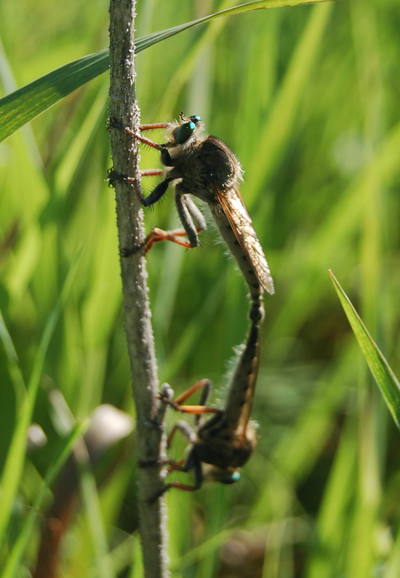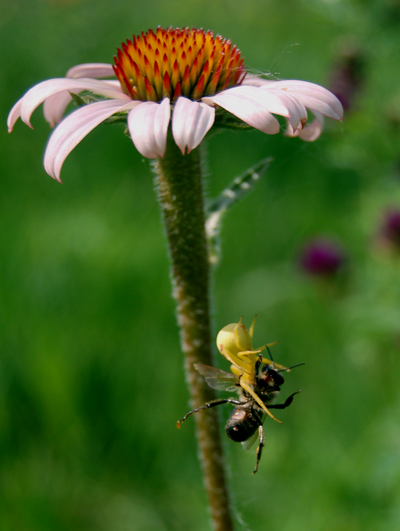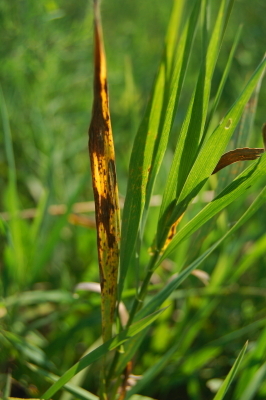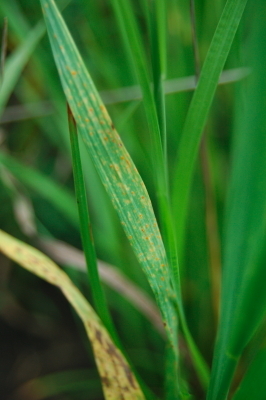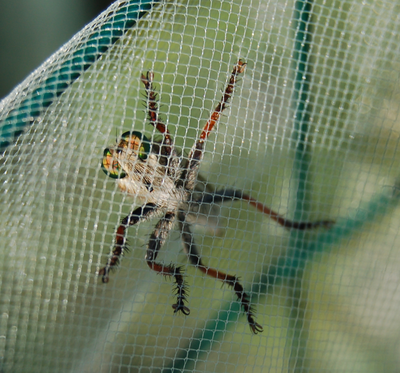|
|
Echinacea angustifolia is flowering late this year.
Peak flowering this year was 27 July. Peak was 12 July and 14 July in 2005 and 2006 respectively. Here’s a rough graph that shows flowering phenology in these years. Red dots are the count of fl plants on each day. Horizontal gray lines indicate days that each plant shed pollen.

See the updated animation of flowering in the common garden experimental plot.
This animated GIF file is a map of all plants that flowered in the CG on each day from July 5 to July 30th. Each dot represents a plants that’s flowering on the day (see upper right corner).
 Click on the thumbnail to see a full-sized image. Click on the thumbnail to see a full-sized image.
 This legend shows plants with 3, 1, and 2 heads flowering (left to right). This legend shows plants with 3, 1, and 2 heads flowering (left to right).

Here is a picture of the “inside-out cucumber” that Per brought into the Hjelm house today. But is it merely a strange vegetable or an apparition of the Virgin Mary? The vegetable says you must make a pilgrimage so that it can give you blessings.
While perusing the BBC Mundo website to improve my Spanish, I ran across an article explaining the relation between tracking bees and tracking serial killers. And apparently, these British scientists are using tiny, tiny radio transmitters to track their bumblebees. An article just about the scientists from February was linked to on the page, and that article even has a video on how they attach the transmitters! Again, no ice packs, but no dominant hand and forefinger, either. Using forceps, it looks like they have the bee put in a special container that presses the bee against a mesh with foam, and then place the tag. Pretty cool, but I think a Melissodes is a little to jumpy for that, compared to a quiet bumblebee. Food for thought, though, I suppose. Thanks, BBC!

Robberflies can catch bees in midair. I’ve never seen it myself but I know that’s not all they can do….


OMG!

The spider could not be reached for comment.
 
There’s something going on with the grasses in the common garden. I’m not sure whether it’s crown rust, but it might be.
Hey everyone,
We’ve been working at organizing and analyzing our data and just wanted to share some of the highlights with all of you and give some tips for next year’s bee squad.
– 9 bee genera recorded
– 72 bees painted
– 258 bees recorded
– 330 flights recorded
– 831 head visits recorded
We’ll post some nice flight maps once we have them put together (Denise is quickly becoming an R expert).
And now some advice for next year…
– For us, it worked well to set 15 minute observation/catching time blocks and to then check on all of the bees in the cooler after those 15 minutes. That way we weren’t trying to catch and track new bees while also trying to paint and track our already caught bees.
– We liked standing two ice packs up in the cooler with the glass vials standing up in between them. This made it easy to see the labeled lids and also preventing the bees from crawling into the lid where it took them much longer to cool down. But be sure to check on the bees frequently because they get colder much faster this way than if the vials were just lying underneath an icepack.
– We placed the bees on a Petri dish to paint them, which gave us a sturdy base for holding them. And of course made use of last year’s paint holsters (made from duct tape and eppendorf tubes) and painting tools (bent section of wire from a flag, sanded and attached by duct tape to a stick as a handle).
– We opted for paper forms over visors, which we liked, but there needs to be a better way to keep track of several bees at once. Having 2 recorders made a huge difference when the bees were active and we had enough people. We could get by with just 2 people on windy/rainy/generally mellow days, but having more was helpful. We’d recommend 2 recorders and at least 4 observers on busy days.
– Somehow none of us had a watch and had to rely on Denise’s cell phone. A watch might be more convenient…
– For the first day or two, it might be a good idea to take the bees back to the Hjelm house and ID them with the bee box.
– Silver and lavender look very similar once they’re on a bee, and it can be hard to tell between silver and white on a bee that was painted a few days before. Likewise, aqua, light blue, and green can be easily confused.
The bees we saw this year were:
– Ceratina calcarata (tiny, black, vertical white line on face)
– Pterosaurus albitarsis, sadly renamed something much less cool (light yellow “W��? shape on face)
– Agapostemon virescens (metallic green head with striped thorax and abdomen)
– Augochlorella striata (whole body is metallic green, but a much smaller bee)
– Melissodes (we saw a few different species, two of which aren’t in the bee box)
– Megachile (the best way to describe their front legs is burly. If I remember correctly, these guys are pretty hairy too)
– Halictus rubicundus (looking at the bee box will give you a more detailed description than I can)
– Dialictus (many different species of tiny black bees. Too small to paint or ID in the field)
– Apis mellifera (Honey bees! The first time Stuart has ever seen a living one on an Echinacea head. They cool down much faster than the other bees, so be careful with them. Also, we got the sense that they mostly hung out on alfalfa and rarely on Echinacea, so that could be an interesting thing to look into)
That’s all for now. We hope you guys are having a great time and getting a lot of measuring done. Stuart, if you have a chance we’d love to get those photos you took on the 17th so we can try to match them up to specific flights. And Megan, thanks for the homemade candy bars!
As of 25 July 2008:
1422 of 1850 heads have started to flower in the common garden.
171 heads are done flowering.
194 of 1033 plants have not started to flower.
Here is a graph showing the number of heads that started to flower on each day.

Here are some clarifications about how mfl and immfl should be filled in for heads in and past the flowering stage. Selecting status “Flowering” means that the last day of flowering is certainly 4 days away or longer. If the last day of flowering is 3 or fewer days away, then select “End of flowering.”
Status
Flowering It is not necessary to fill in mfl, ffl, or immfl. (mfl and Immfl are presumed to be well over 11).
End of flowering Fill in mfl and immfl! (Both may 11.)
Last day of flowering Fill in mfl and immfl! (immfl should be zero.)
Done flowering Fill in mfl and immfl! (mfl & immfl should be zero.)
Note 1: When the action is xxxx, then fill in a status (usually: flowering, end of flowering or done).
Note 2: When status is “Flowering,” “End of flowering,” “Last day of flowering”, or “Done flowering” then don’t fill in ffl!

|
|
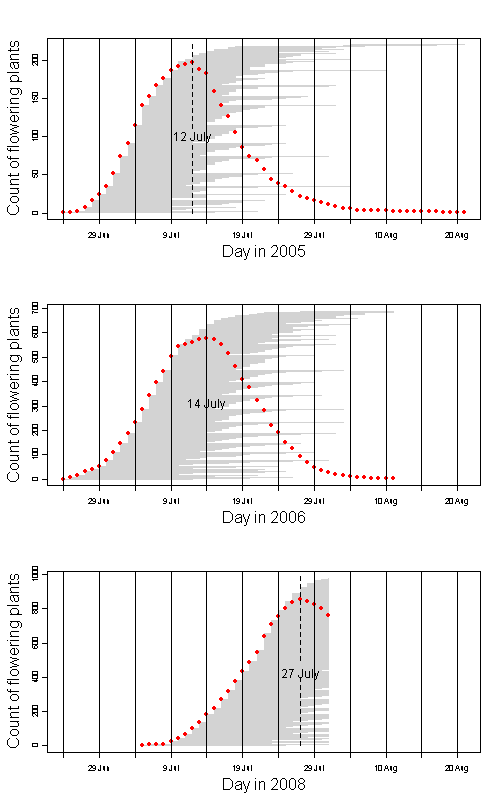
 Click on the thumbnail to see a full-sized image.
Click on the thumbnail to see a full-sized image.![]() This legend shows plants with 3, 1, and 2 heads flowering (left to right).
This legend shows plants with 3, 1, and 2 heads flowering (left to right).
